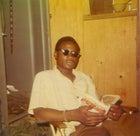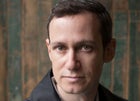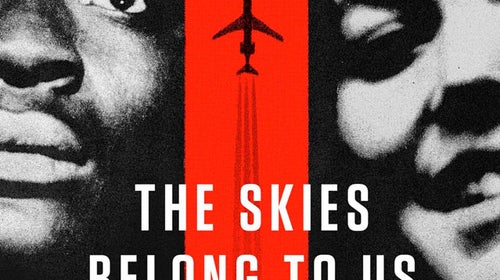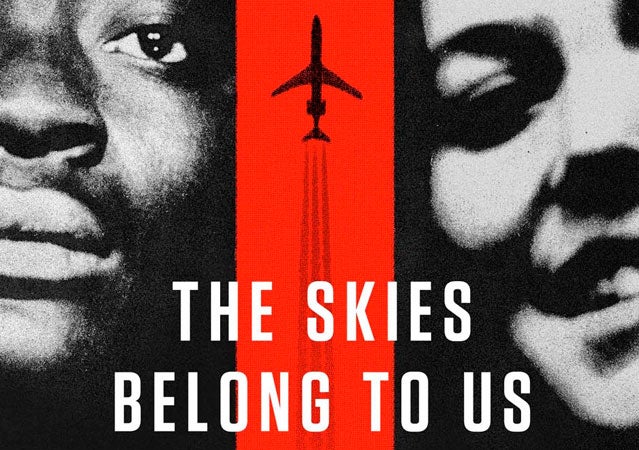Even if you were around during the heyday of airline hijacking, you’ll be amazed by the details in new book, (Crown, $26). Koerner combines a rich overview of this period with a deep look at a single crazy episode of sky piracy: a 1972 hijacking that featured a disturbed Vietnam vet, a beautiful hippie girl from Coos Bay, Oregon, the Black Panthers, and a wild ride that took the outlaws from California to Algeria to France without a scratch. (Although they did encounter plenty of turbulence, then and later.)
 Roger Holder
Roger Holder_si.jpg?width=140) Cathy Kerkow from the 1969 Marshfield High School yearbook
Cathy Kerkow from the 1969 Marshfield High School yearbook Author Brendan I. Koerner
Author Brendan I. KoernerBetween 1961, when a Florida electrician named Antulio Ramirez Ortiz whipped out a knife aboard a flight from Miami to Key West and demanded to be taken to Cuba, and 1973, when the crime wave petered out after the long-overdue introduction of metal detectors in U.S. airports, 159 commercial flights were hijacked in this country. At first, most hijackers simply wanted to go to Havana, operating under the mistaken assumption that Fidel Castro would welcome them as heroes. (They usually ended up in detention or a labor camp.) By 1972, hijacking had evolved from a stunt to a serious safety menace, and an irate American public welcomed aggressive tactics, usually mounted by the FBI, that sometimes resulted in the deaths of hijackers and passengers alike.
Koerner, 38, wraps all the mayhem into an unforgettable adventure tale. In a conversation with ���ϳԹ��� editorial director , he talks about why hijacking caught on in the first place and the surprising reasons why it lasted so long.
OUTSIDE: You’re too young to have grown up watching hijack coverage on the six o’clock news. How did you become aware that all this happened?
KOERNER: In October 2009, I was reading the Metro section of The New York Times, and I saw a small piece about a guy named , who was a Puerto Rican nationalist who’d been living in the Bronx in 1968. That year he hijacked a plane to Cuba with two of his comrades, and he ended up spending the next 41 years living there. Then, suddenly, as a senior citizen—he was 66 at the time—he decided to come back to the U.S., where he’d left behind a wife and daughter. This piece was about him getting arrested at JFK the second he stepped off the plane.
I was vaguely aware that people used to hijack planes to Cuba. But I didn’t know much about how often it happened and what the motives were. I started looking into what was going on back then, and I was blown away by how common hijacking once was.
As you show in the book, the hijacking spree lasted roughly ten years. Walk us through when it got started in the U.S. and how things changed over time.
There were three phases. The first was the longest, lasting from about 1961 to 1969, and it’s what I call the Cuba phase. In this period, the only demand people had was to go to Cuba. A lot of hijackers thought it would be some fantastic paradise, a lot had grievances against the federal government, and some had personal issues—often mental-health issues.
In 1969, there was a milestone hijacking by an Italian-American marine named Rafaelle Minichiello, who was the first hijacker to demand to go somewhere other than Cuba. He wanted to go to Italy. TWA, the airline involved, had no procedure for dealing with this—nobody had asked this before—but they took him to Italy, because they just wanted the plane back and the passengers safe. That marked a new phase. Suddenly, people wanted to go places other than Cuba, like Sweden, Argentina, or Algeria.
The third phase came when people started asking for money, and this began in 1970 with a man named Arthur Gates Barkley. He was an unemployed bakery-truck driver from Arizona who had a dispute with the IRS, and he became enraged that the U.S. Supreme Court would not hear his appeal. He hijacked a plane and demanded $100 million, to be paid by the Supreme Court as his revenge for them not taking his case. Again the airline involved was TWA, and they tried to mollify him with about $100,000. That hijacking didn’t end well for Barkley—he was shot and captured at Dulles Airport—but it was a precedent, showing people that airlines were prepared to pay. People started asking for more and more money, and things really spiraled out of control in 1972.
Along with the case you focus on in the book, what’s another good example?
Southern Airways flight 49, in November 1972. A trio of criminal fugitives—two men from Detroit and one of their half-brothers from Tennessee—hijacked a plane in Alabama and demanded $10 million. They said that if they didn’t get it, they were going to crash the plane into the nuclear reactor at Oak Ridge National Laboratory. The airline managed to get $2 million—which, fortunately, the hijackers accepted, probably because they didn’t count it.
I was amazed at how the airlines reacted to this problem. I had no idea that they were the major political impediment to establishing security measures that would slow down or stop hijackings.
For a long time, airlines treated hijacking as a managed risk. They saw two options. They could endure between 20 and 40 hijackings a year, and they would have to pay some money in the form of the hassle of getting the plane back, compensating passengers, and all that. Or they could put metal detectors in every single airport in America and hire lots of additional security personnel. They weighed those two things and decided it would be much more expensive to put in basic security. They were also concerned about the loss of travelers who would choose to drive rather than fly. The airlines had powerful lobbying operations then, and they were able to shut down legislation aimed at boosting security.
The star of the book is an African-American Vietnam veteran named Willie Roger Holder, who did four tours and had seen gruesome combat over there. You make it clear that combat-related trauma and anger were factors in what he did, but he also seems to have had mental-health issues separate from that. Do you think he would have gone down this path if he hadn’t had such disturbing war experiences?
I wondered about that a lot, and certainly in the psychiatric reports on him there were a variety of diagnoses, ranging from anxiety disorders to bipolar disorder to schizophrenia. It’s difficult to separate out what caused him to act. But there’s no question that he was suffering from psychiatric disorders that grew worse over time.
How did this incident start?
It started when Holder, by accident, met a 20-year-old woman from Oregon named Cathy Kerkow. In January 1972, he knocked on an apartment door looking for a woman he’d known in San Diego. Kerkow, who was her roomate, answered instead. She and Holder immediately latched onto one another, and it turned out they had a bit of a secret past. Holder’s family had briefly lived in Coos Bay in 1959, when his dad, who was in the Navy, was stationed there. They were one of the very, very few black families in town, and they were basically run out, treated quite harshly by some racist residents. Holder and Kerkow had very briefly crossed paths during his time in Coos Bay.
Holder was very into astrology. He remembered their encounter, and he thought this was a cosmic sign that they were meant to do something big together. He eventually decided that he and Kerkow were meant to hijack a plane, and to try to liberate the imprisoned black radical Angela Davis, who was on trial for murder.
As you explain, Davis wasn’t accused of directly murdering anybody. The charge was that she provided weapons that were used in a murder.
Yes, it was a conspiracy case. And what Holder wanted was to exchange the passengers for Davis and some money, and then take Davis and the money to North Vietnam. All as a way to atone for some of the guilt he felt about the war.
As a reader, it was easy for me to comprehend what led Holder to do something so rash, but it was harder with Kerkow. She’s basically just working and partying in San Diego, falls in with Holder, and keeps casually making the next wrong choice. How did she strike you?
One thing to keep in mind is that she was 20 years old and not terribly worldly. She’d left Oregon just a few months before she met Holder. This was her first time in the big city, in this kind of hippie, party lifestyle in San Diego. I think she was somewhat overwhelmed. And she had a big rebellious streak. She was the oldest of four children from a family the father had walked away from, which was rare in that era.
But did she make some bad choices? Certainly. I think she’d be the first to admit that. But a lot of people around that age make some awful choices on the spur of the moment. It’s pretty much a hallmark of being 19 or 20.
So their plan was to free Davis and fly to Hanoi. Davis wants no part of it, but the hijacking happens and they end up going to Algeria instead, partly because Holder admires Eldridge Cleaver, a famous Black Panther and the author of Soul On Ice. He had settled in Algiers with a rather costly entourage.
Cleaver was Minister of Information of the Black Panther Party, and he’d been involved in a shoot-out with police in the San Francisco Bay Area, which resulted in the death of one of his comrades. He’d been indicted for attempted murder, and he jumped bail, fleeing first to Cuba, where he quickly wore out his welcome because he had a big mouth.
He went to Algeria instead, which at that time was the way Venezuela is today—a revolutionary, socialist, deeply anti-American place—and they let Cleaver set up what he called the International Section of the Black Panther Party. They were given a villa in a nice section of Algiers, and a lot of exiled Black Panthers came there to crash with Cleaver and his family. And that’s where Holder and Kerkow ended up.
The Panthers and their dependents—men, women, and children—have pretty high living expenses, so the main thing they want from Holder is the cash. Not to give too much away, but I’ll just say that this leads to some very entertaining moments in your book as the Panthers jockey to get the loot.
This happened at the tail end of the Panthers’ heyday, a time when the party was fracturing, the FBI had had this secret program to stoke paranoia and dissension in the party. And you had Cleaver, this incredibly charismatic guy, leading what I’d characterize as a commune. But I think his passion for the fight had been chipped away during his years in exile, and I think he had become much more focused on his selfish needs and desires by that point.
It’s a given that you’d do well with a Jeopardy! category called Skyjack, so let’s close with a couple of quick ones. Of all the hijackers you survey, who was the scariest?
John DiVivo, who hijacked a Boston-to-Newark Eastern Air Lines flight in March 1970. He told the pilots to fly out over the Atlantic until they ran out of fuel and crashed, but before that happened he shot them both for no apparent reason. One of the pilots managed to disarm DiVivo despite being mortally wounded himself, and DiVivo later committed suicide while awaiting trial.
And the dumbest?
It has to be Stanley Harlan Speck, who hijacked a Pacific Southwest flight out of Oakland, California, in April 1972. He wanted to go to Miami, but the pilots talked him into landing in San Diego first, ostensibly so they could pick up some navigational maps. When Speck foolishly left the plane to get the maps himself, he was promptly tackled by a pair of FBI agents disguised as mechanics. You know what the funniest part was? Speck was a graduate of Stanford.


